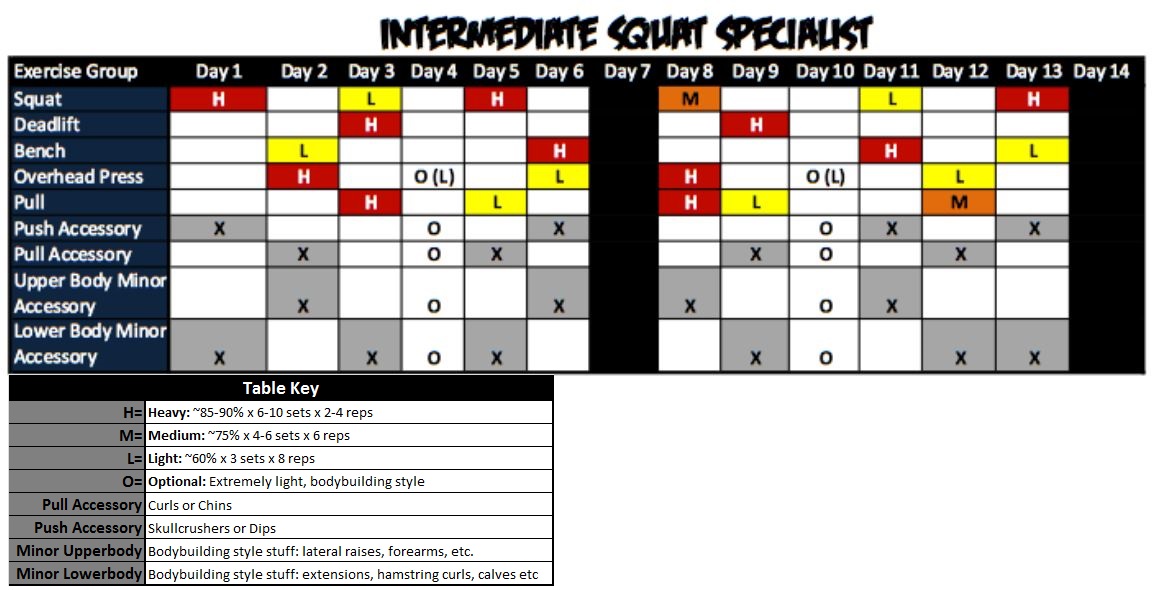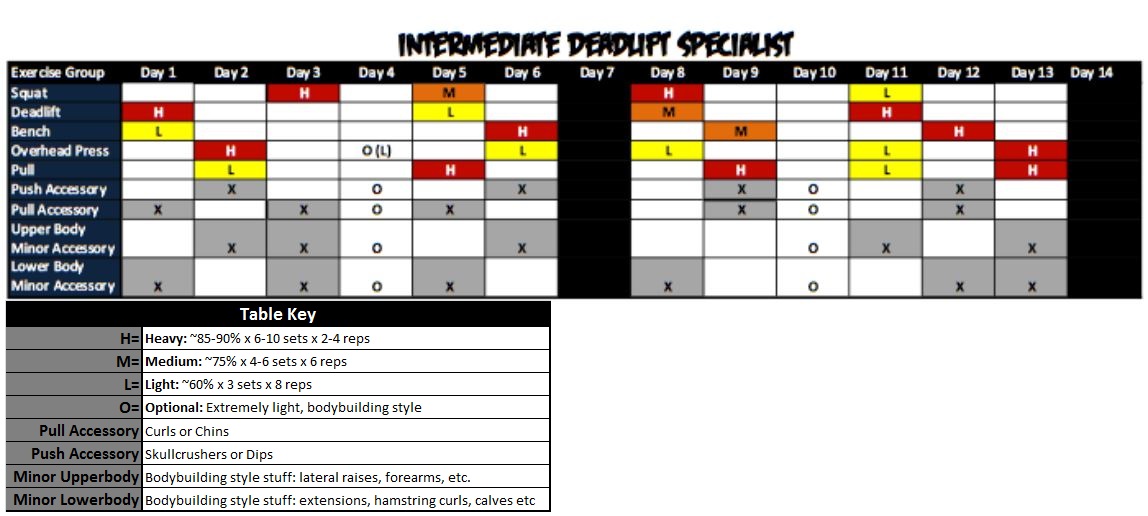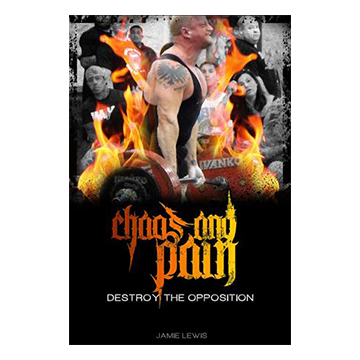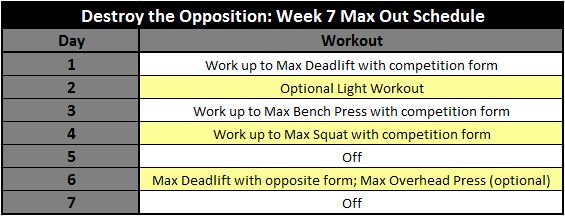The programming review series has taken us all over the place with regards to powerlifting programs, but no stop thus far is more in your face than this one is going to be: today we will review Jamie Lewis’ Destroy the Opposition. For those unfamiliar with Lewis’ ChaosNPain blog (NOT SAFE FOR WORK!), Lewis has made quite the name for himself both with his world record caliber lifting and his angry, offensive style of writing. Some people love him and some people hate him – none of which has anything to do with whether or not his programs are any good.
And that is the only question we are concerned with here in the PowerliftingToWin Programming Series. As it so happens, Destroy the Opposition, in my opinion, is one of the more worthwhile powerlifting eBooks on the entire market. At $20, it might be considered a bit pricey, but you get nearly 200 pages of highly entertaining, albeit offensive, content.
Destroy the Opposition is not a “program” book so to speak. That is, this book is not about Jamie Lewis and his personal method. Lewis describes the book as his “opus” on powerlifting and that is a much more accurate description. Lewis does pepper in quite a bit of his own personal philosophies, but the vast majority of the content in the book centers around the history of the three powerlifts including both the greatest lifters ever to perform each lift and the history of the lifts themselves. If you love to read about the all-time greats and the routines they used, Destroy the Opposition is going to be an amazing resource for you. Lewis covers around a dozen all-time great lifters and their routines for each of the powerlifts.
In the very last few pages of the book, Lewis offers forward his own programs of which there are five: a beginner routine, an intermediate squat specialization routine, an intermediate deadlift specialization routine, an advanced squat specialization routine, and an advanced deadlift specialization routine. Lewis defines beginners as anyone with less than six months to a year of experience or so. He defines advanced athletes as those lifting for four years or more. As such, we’re going to focus on the intermediate programs in the book because I feel they present the best combination of interesting material and relevance to the PowerliftingToWin audience.
If you’re a beginner, I’d recommend taking a look at other programs. If you’re advanced, the programs are definitely worth your while, but there is just not enough advanced lifters out there who care to see programming reviews.
Without further ado, let’s break down Lewis’ intermediate routines.
If you’d rather watch than read:
Destroy The Opposition: Background and Context
Again, if you’re the type of person who is easily offended, you don’t want to read Lewis’ material. He is flamboyant, outspoken, and, often times, quite crude. He’s also very strong, intelligent, and well-researched. Everything has its price, I suppose. I just mention this because Lewis is the type of guy who regularly includes porn and profanity on his training blog. If you’d rather avoid that type of thing, I understand. Fair warning has been served.
That said, Lewis is the former all-time world record holder in the 181lbs weight class for raw powerlifting (no knee wraps). He totaled 1705 which is still 2nd all-time only to Ben Puccio’s 1710. Lewis also briefly held the world record for the raw squat (without wraps) with his 650lbs effort at 181lbs. That is 2nd all-time only to Vladislav Lukanin’s 672lbs. In other words, Lewis puts his money where his mouth is. He’s the real deal.
Lewis’ credentials are perhaps exceeded only by his personality. And, really, it should be no surprise that his programs tend towards the extreme side just as he does in general.
Jamie Lewis totals 1705:
Destroy The Opposition: The Intermediate Routines
Lewis believes that all lifters should essentially pick between the squat and the deadlift. He doesn’t believe it is realistically possible to dominate in both lifts simultaneously because of how much overlap there is between the two lifts; they tax very similar bodily systems. Likewise, he doesn’t believe that the bench offers most people enough of an opportunity to separate yourself from the back because of the relatively smaller poundages handled. Lewis is all about winning. As such, he suggests getting ridiculously good at one of the lifts via specialization. As a consequence, his suggested routines emphasize either the squat or the deadlift.
The Intermediate Squat Specialization Routine
The Intermediate Squat Specialization Routine is as follows:

The basic gist here is that you’re operating within two week microcycles. After you repeat three microcycles (six weeks of training), you’ll take a max on each lift and restart the program using your new max as the basis for determining your work set weights.
You can see that this program features a lower body frequency of about three or four times in the first week and five or six in week two. In each week of the microcycle, you’re going to do squats three times per week. This being a squat specialization routine, you perform the deadlift only once per week. You’re going to bench twice a week on a heavy-light scheme, but you train upperbody between three and five times per week depending on if you perform the optional workouts.
While the program looks complex and somewhat intimidating, you have to realize that Lewis isn’t suggested all that much more volume than what other programs suggest. However, instead of doing eight exercises per workout, Lewis has you doing four or five. He has simply increased the frequency to make sure you still get all of the same work in. I am generally a fan of this approach.
The Intermediate Deadlift Specialization Routine
The Intermediate Deadlift Specalization Routine is as follows:

You can see that there are a lot of similarities between the deadlift specialization routine and the squat specialization routine.
In terms of upperbody, you’re still training between four and six times per week depending on if you do the optional workouts. You’re going to bench twice per week on a heavy/light scheme. You’re also going to do a lot of pressing and occasional days where you hit some upperbody accessories to round out the frequency.
Lower body is where we see the biggest differences. Instead of squatting three times per week, you’re squatting only twice per week on a heavy/light scheme. Deadlifting is upped to twice a week. You pull heavy once a week and there is either a medium or light session in-between the heavy pulling.
Planning
Despite Lewis being a powerlifter, and this being a powerlifting program, a detailed peaking plan is not included. After each six week period, you’re supposed to max out and Lewis does include a schedule for doing so.
Presumably, if you wanted to do a meet, you’d place the meet on that 7th week and max out at the meet instead. Lewis has an entire book dedicated to peaking strategies so perhaps that is why this one is particularly sparse in dealing with the subject.
Periodization
In an interesting twist, Lewis actually doesn’t include traditional periodization in any of his plans. You’re just repeating the same two week microcycle over and over and over again. This is fine for the early intermediate lifter, but it is my personal belief that late stage intermediates and advanced athletes are going to benefit from longer cycles and some type of periodization, respectively speaking.
A complete lack of periodization doesn’t necessarily bode well for long term, continued progress. I’m not sure this is enough variation. Then again, these are the intermediate routines we are reviewing and, by definition, an intermediate doesn’t need much in the way of periodization. They can progress via manipulation of volume and intensity alone. For most intermediates, this shouldn’t be a real obstacle.
Programming
Lewis goes to great extents to ensure appropriate programmatic variety from week to week and workout to workout.
You’ll notice that you never perform two “heavy” protocols in the same workout. The only exception is one day where you go heavy on overhead press and rows. However, because of their nature, both of these exercises feature less absolute intensity (poundage on the bar). This makes the recovery more manageable.
Whenever you perform a heavy lower body workout, you take the next day off of lower body training. The same is mostly true for the upperbody. After a heavy day, you either take the next day off of upperbody training or you’re only performing a light day with minimal accessories. Again, this is to help manage recovery between sessions.
You never go heavy on the same movement twice in a week. There is always variation from workout to workout for each movement. This is the hallmark of appropriate intermediate training.
In fact, in many ways, Lewis has organized this program into different sessions where you’re doing high volume, medium intensity and other sessions where you’re doing high intensity, medium volume. As we’ve learned from studying the Texas Method and Candito’s Linear Program, this is a GREAT way to provide programmatic variation for the intermediate trainee.
The division of intensity between the two weeks of the microcycle is highly intentional. You can take another look at it for yourself to see that Lewis has clearly structured things in such a manner as to facilitate both intra-week and inter-week recovery.
Specificity
Lewis has done a pretty damn good job of specificity in my opinion. The vast majority of the volume that you’re performing is coming on the main movements. This isn’t variations of the main competition movements either; you’re actually performing the competition movements for volume. Not only that, but you’re going heavy! What a concept, right? Lift heavy to lift heavy.
There isn’t an exorbitant amount of unnecessary bodybuilding fluff either. That said, there is still some in there which is nice because we all know that most of you are going to go off of your program and do it anyways. You might as well include some guidelines for structuring curls, calves, and abs, because, if you don’t, Johnny Novice is going to do the eight hour arm workout and fuck up his whole training week.
The one criticism I have of this program in terms of specificity is the emphasis on overhead pressing and rowing. You’re doing, basically, equal amounts of overhead pressing and benching. You’re doing more rowing than deadlifting. This is very, very typical in American powerlifting programming and I strongly disagree with it. If you’re a bodybuilder or a “powerbuilder” (someone who wants an even mix of strength and size) then fine. Do your damned rows to your heart’s content. However, for a competitive powerlifter, by toning down the overall overhead pressing volume and rowing volume, not necessarily eliminating it mind you, you can do more deadlifting and benching which is flat out more beneficial to the powerlifter. With less overhead pressing, this template could easily feature thrice weekly benching which I am a big fan of. You’d likely also be able to deadlift twice a week even on the squat specialization template.
This is why I don’t advocate for an abundance of rowing and pressing. It isn’t that these movements aren’t awesome, worthwhile, and capable of making you stronger, it is that performing them directly takes away from the total amount of deadlifting and benching you can do. Which do you think will do most to help your total: deadlifting twice a week and rowing once per week or rowing twice a week and deadlifting once per week? For me, the answer is common-sensical and intuitive – obviously, deadlifting twice is better ASSUMING you can recover from both.
Overall, Lewis’ programs does pretty damn well on specificity, though.
Overload
This program features basic progressive overload. Every six weeks you take a new max. Based on this new max, which is hopefully higher than your previous maxes, you will handle heavier weights due to the fact that a % of a higher number means more weight on the bar for your work sets. As you get stronger, the program calls on you to lift heavier weights. Hence, we’re dealing with progressive overload.
Fatigue Management
Now, I’m sure a lot of you are expecting me to jump all over this program for being “too high” in terms of frequency, but, actually, I’m not going to do that. This is a perfectly legitimate way to organize programming for younger guys in my opinion.
You see, even though this program features five times per week frequency, this is only due to the way Lewis is dividing the workload. You’re not squatting five times per week. You’re not deadlifting five times per week. You’re not benching five times per week. You’re squatting 2-3 times per week, deadlifting 1-2 times per week, and benching twice per week. That sounds a lot more reasonable, doesn’t it? Instead of doing full body, the routine is split into separate days. There’s nothing wrong with this. Many, many people report that doing “split” routines improves their recovery. This is just a more advanced split – that’s all it is.
Now, I’m not advocating for super low volume, high frequency workouts. That is not what Lewis is doing here. Instead of giving you eight exercises per workout, he’s giving you four and then putting the rest of the work on another day. This is different than, say, the Bulgarian method where you might do a total of six or seven working reps in an entire workout, but you repeat that workout five or six times a week (or more).
I think some of the workouts are kind of pointless. For example, are you really going to get an upperbody training effect from a day where all you do is a “minor upperbody accessory” such as wrist curls? Nothing substantial is going to happen with that. Now, it does count towards increasing frequency, but, in my opinion, this is a harmless, innocuous addition designed to placate all of you guys out there who just HAVE to do “bodybuilding assistance” to be psychologically satisfied with your workouts.
The one thing I will say here is that I don’t think this type of program will be handled well by older guys. It is just a bit too much. You’re doing significantly more volume and “stuff” than you would on something like the Texas Method. While the Texas Method does feature higher relative intensities on the volume work, it also less overall work and still buries lots of people with sub-par recovery. I suspect this program would do the same even.
Lewis’ programs calls for one day of 4-6 sets of 6 at ~75% and another day of 6-10 sets of 2-4 reps at 85-90%. The Texas Method calls for one day of 5 sets of 5 at ~72-77% and another day of 1 set of 5 at 85%. Compare the total volumes and you can see that, once you factor in all the accessory work, this program is substantially more overall work. Practical experience shows that this will crush some people even if they do the minimum amount prescribed by Lewis.
However, for you younger guys, this is ambitious, but the fatigue management is still appropriate.
Individual Differences
Unlike so many popular programs, Lewis actually does incorporate quite a bit of leeway for individual differences; Lewis’ programs do incorporate a high degree of autoregulation.
Now, Lewis doesn’t use RPEs or load drops to regulate intensity and volume, but he does prescribe rep ranges and set ranges instead. Because you’re given a rep range and a set range, rather than a specific prescription, you can adjust the weights to get inside the intended range. Even though this doesn’t incorporate RPE, it does incorporate your performance to determine weights. Likewise, because you’re given a range of sets to perform, how much total volume you is somewhat up to you.
That said, while Lewis’ program rates exceptionally well on individual differences comparatively speaking, ranges are still inferior to RPEs and fatigue percents for a few reasons.
Let’s focus on volume. If you prescribe someone a range of sets and tell them to “listen to their body” they might not know what that means. They might just opt to do the maximum amount of sets every single time. More is better, right? Also, it is conceivable that your range isn’t big enough to accommodate everyone. Some outliers might fall below the minimum bound of the range and others above the maximum.
Most importantly, even with a volume range, you don’t know what effect your volume prescription is having. On one day, six sets might produce a 10% drop in performance – a.k.a. 10% fatigue. On another day, six sets might produce a 5% drop in performance. One of these workouts is MUCH more stressful than the other despite the same total amount of volume. This is why more sophisticated autoregulatory measures are preferable.
Nonetheless, Lewis earns major props for being one of the few guys to incorporate some autoregulation into his program.
Final Thoughts
I am biased towards a lot of the same proclivities as Lewis. Namely, I think most people don’t work hard enough, don’t do enough total work, and aren’t focused on WINNING. Naturally, I gravitate towards his ideas and philosophy as a result. That said, I really did enjoy Destroy the Opposition. The book is highly informative and entertaining even if you have no intention of running his programs.
And as far as his programs go, as you can see, they’re pretty damn good. I’m skeptical of the fact that he doesn’t include any periodization whatsoever, I’m not a fan of the amount of overhead pressing and rowing, and I’d like to have seen some more sophisticated forms of autoregulation being employed, but, in the grand scheme of things, I’d still recommend these programs to young early intermediate powerlifters.
You’re going to be doing an ambitious amount of volume, the frequency is high, the specificity is pretty good, you’ll actually be lifting heavy, you’ll challenge yourself, and I just agree with the general way Lewis has set-up the program. In my opinion, Destroy the Opposition is one of the better options we’ve looked at for early intermediate trainees. You can grab a copy of the book here.
Moving Forward
The end of the programming series is now in sight. If you have final requests, make them known!
The next program we’ll be taking a look at is the Coan/Phillippi Deadlift Routine. I’ve received numerous requests for this one. Despite the fact that this isn’t even what Coan actually did to build his deadlift, it is one of the most popular deadlifting programs ever written and, as such, I cannot in good conscience ignore it even though I have an urge to do so. If you’ve been wondering about Coan/Phillippi, be sure to check out the next review.
Did You Enjoy The ProgrammingToWin Series?
If so, you’ll absolutely love our eBook ProgrammingToWin! The book contains over 100 pages of content, discusses each scientific principle of programming in-depth, and provides six different full programs for novice and intermediate lifters. Get your copy now!
Like this Article? Subscribe to our Newsletter!
If you liked this articled, and you want instant updates whenever we put out new content, including exclusive subscriber articles and videos, sign up to our Newsletter!
Questions? Comments?
For all business and personal coaching services related inqueries, please contact me:
Table of Contents
Powerlifting Programs I: Scientific Principles of Powerlifting Programming
Powerlifting Programs II: Critical Training Variables
Powerlifting Programs III: Training Organization
Powerlifting Programs IV: Starting Strength
Powerlifting Programs V: StrongLifts 5×5
Powerlifting Programs VI: Jason Blaha’s 5×5 Novice Routine
Powerlifting Programs VII: Jonnie Candito’s Linear Program
Powerlifting Programs VIII: Sheiko’s Novice Routine
Powerlifting Programs IX: GreySkull Linear Progression
Powerlifting Programs X: The PowerliftingToWin Novice Program
Powerlifting Programs XI: Madcow’s 5×5
Powerlifting Programs XII: The Texas Method
Powerlifting Programs XIII: 5/3/1 and Beyond 5/3/1
Powerlifting Programs XIV: The Cube Method
Powerlifting Programs XV: The Juggernaut Method
Powerlifting Programs XVI: Westside Barbell Method
Powerlifting Programs XVII: Sheiko Routines
Powerlifting Programs XVIII: Smolov and Smolov Junior
Powerlifting Programs XIX: Paul Carter’s Base Building
Powerlifting Programs XX: The Lilliebridge Method
Powerlifting Programs XXI: Jonnie Candito’s 6 Week Strength Program
Powerlifting Programs XXII: The Bulgarian Method for Powerlifting
Powerlifting Programs XXIII: Brian Carroll’s 10/20/Life
Powerlifting Programs XXIV: Destroy the Opposition by Jamie Lewis
Powerlifting Programs XXV: The Coan/Philippi Deadlift Routine
Powerlifting Programs XXVI: Korte’s 3×3
Powerlifting Programs XXVII: RTS Generalized Intermediate Program


Maybe you want to look at the Norwegian programs from the Norwegian coach.
They are kinda basic and not what the top people use.
1st is novice
2nd intermediate
3rd is a volume
they are in norwegien so might be hard i can translate if you need it.
http://styrkeloft.no/treningsprogram/
If you can provide a translation of the programs as well as any accompanying explanation for them, I’d love to take a look at the Norwegian style.
If I understand correctly, those programs might actually be outdated or at least basic and not representative of what Norwegian top lifters actually do at the moment. I could be wrong though. But they seem to train with much higher frequency. They also have their coach who probably individualizes their program, so not all are doing the same thing or training with the same frequency.
Scroll down to “The Frequency Project” in this article: http://articles.elitefts.com/training-articles/reignite-progress-with-new-science/
This interview also gives some insights: http://bretcontreras.com/an-interview-with-marte-elverum-a-womens-norwegian-elite-powerlifter/
You could check some logs from Norwegian lifters on http://www.trainingblog.com/ for some examples.
Sorry Marius! I missed that you already said they are basic and not what the top lifters use.
I have translated the novice and the guide for using it anywhere i can send it to you its in word and excel format
yea they are not very current top lifter in the national team get custom programs of course but alot of lifters in Norway use them but alot add extra days.
Just though it be fun to see a program from a IPF coach that trains the top lifter in the ipf right now 1200kg CYC.
You should review Victor Pride’s Body of a Spartan program.
Great series so far. What about Mike T’s generalized intermediate program?